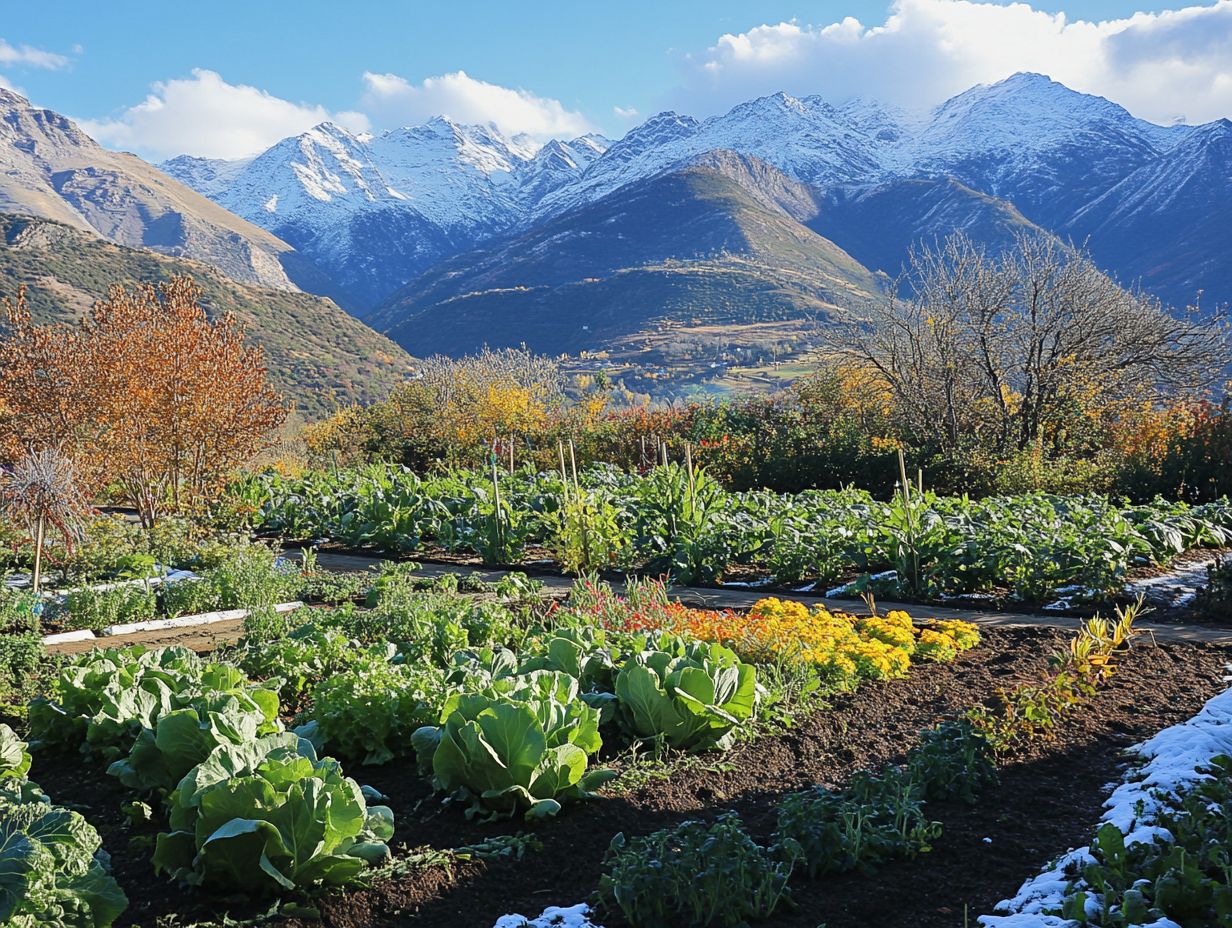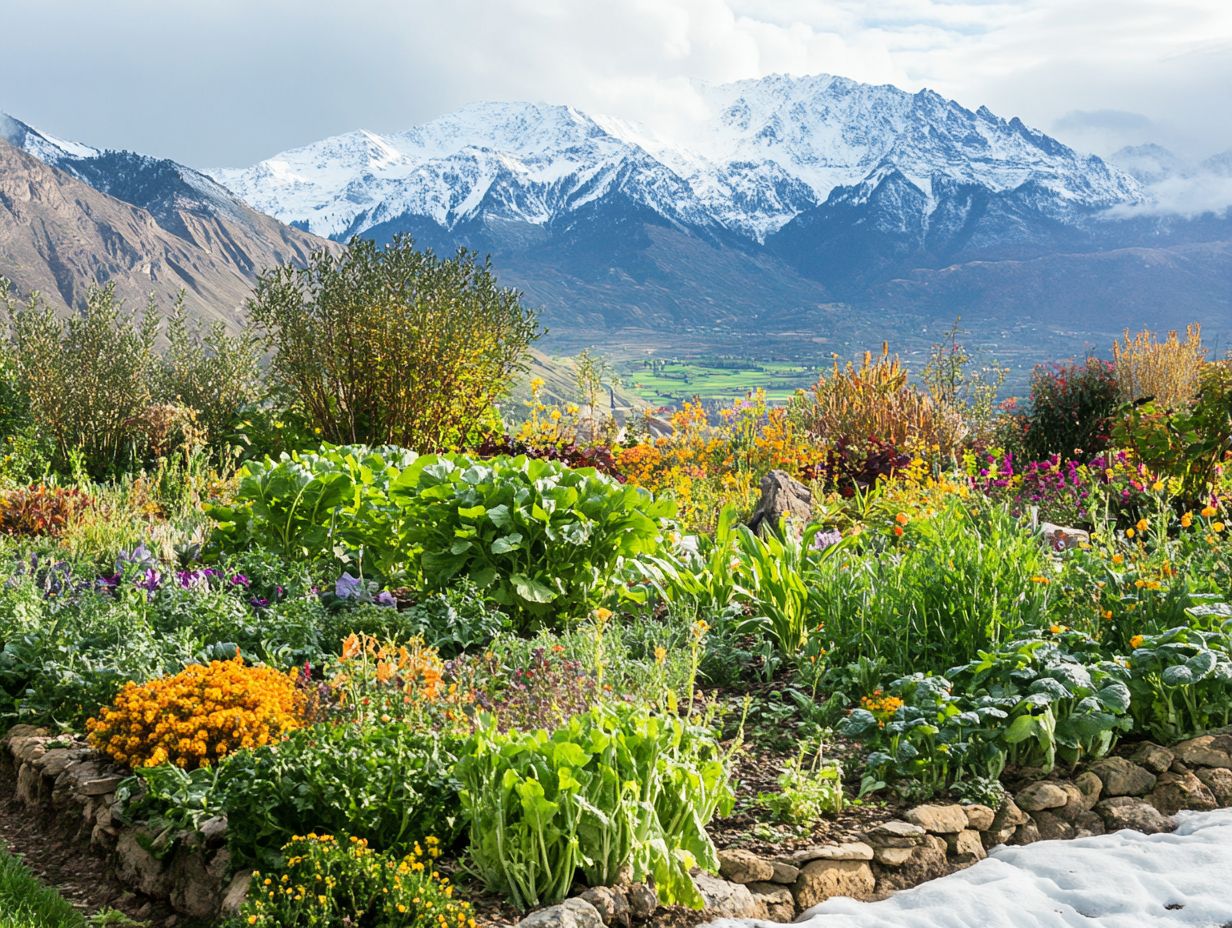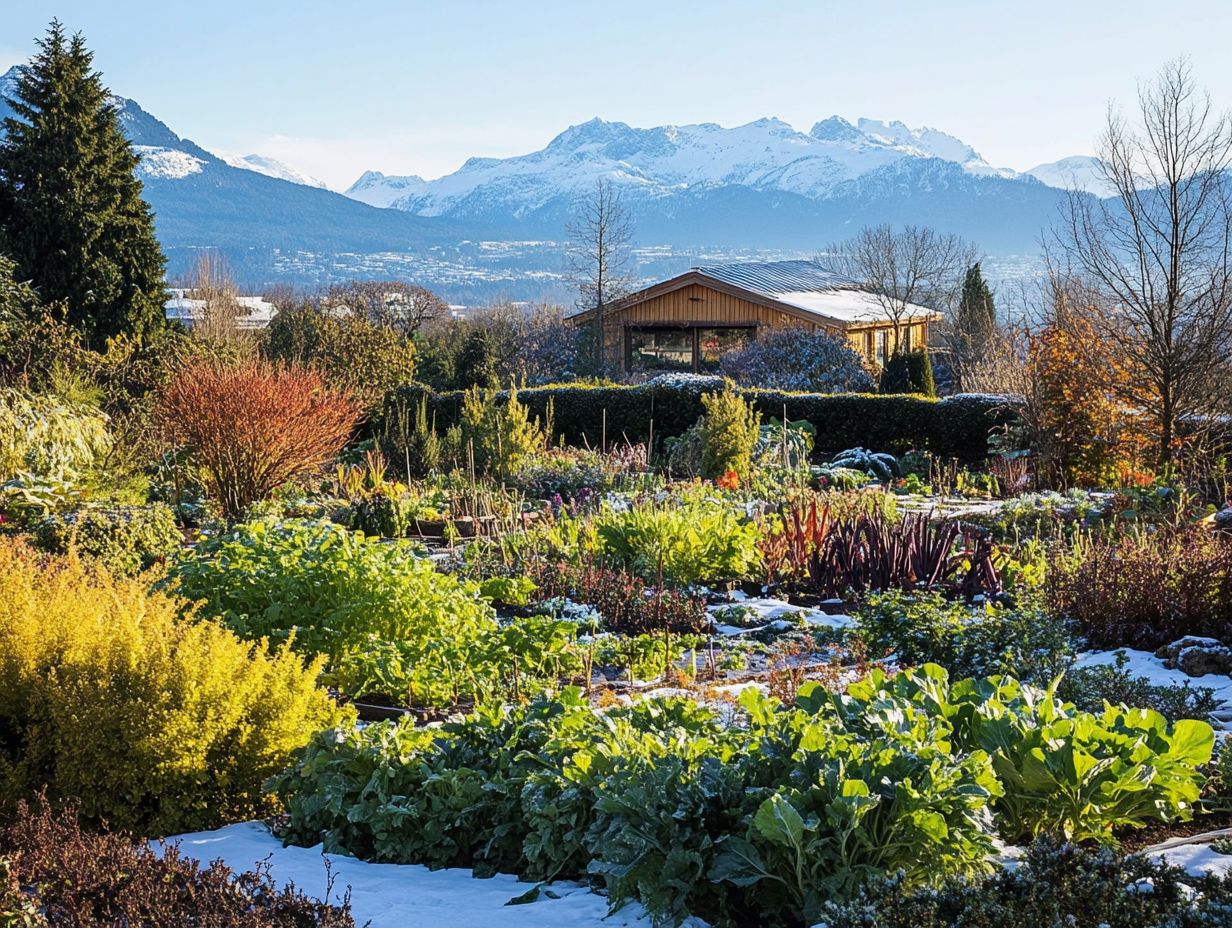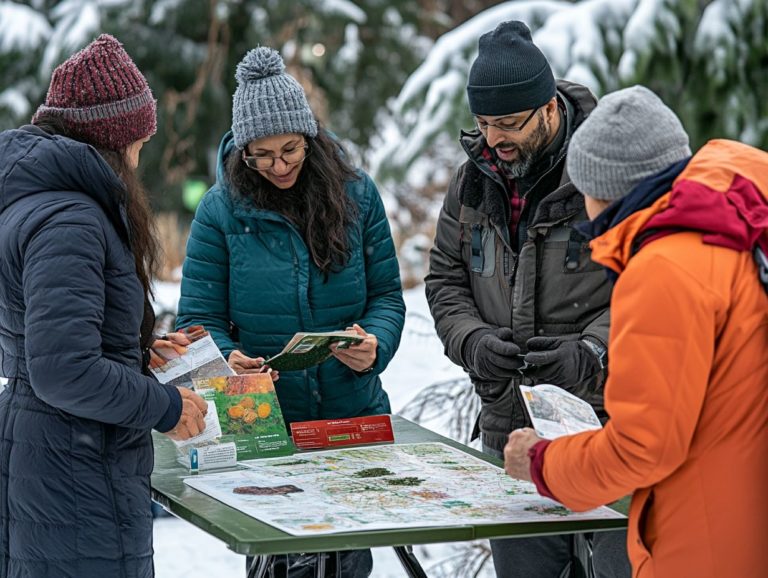Choosing the Best Plant Varieties for Cold Climates
Gardening in cold climates presents both a rewarding challenge and a captivating opportunity, particularly for those interested in a variety of winter plants.
To achieve success, it’s crucial to understand the unique factors that influence plant growth in these environments, including how cold weather affects various plant species. From choosing the right cold-hardy plants to understanding climate zones, soil types, and sunlight requirements, this guide will explore the details of cold-climate gardening.
You can also learn effective ways to care for your plants, along with alternative options such as indoor gardening and greenhouse techniques that help you maximize your gardening efforts, no matter what the weather brings.
Contents
- Key Takeaways:
- Understanding Cold Climates and Plant Growth
- Types of Plants that Thrive in Cold Climates
- Key Factors for Choosing Cold-Climate Plants
- Care and Maintenance for Cold-Climate Plants
- Alternative Options for Cold-Climate Gardening
- Frequently Asked Questions
- 1. What factors should I consider when choosing the best plant varieties for cold climates?
- 2. What are the hardiness zones and how do they affect plant selection for cold climates?
- 3. Are there certain types of plants that are better suited for cold climates?
- 4. How can I protect my plants during winter in a cold climate?
- 5. Can I still have a variety of plants in a cold climate?
- 6. Can I grow tropical plants in a cold climate?
Key Takeaways:

- Choose cold-hardy plants, such as conifers and flowering shrubs, that can withstand cold temperatures and harsh conditions.
- Consider the climate zone, USDA hardiness zones, soil quality, and amount of sunlight when selecting plants for a cold climate.
- Proper care and maintenance, such as using best gardening practices and monitoring water levels, can help ensure the health and growth of plants in cold climates.
Understanding Cold Climates and Plant Growth
It s important to know how cold climates affect plant growth for any gardener looking to cultivate vibrant flower beds filled with hardy plants or lush landscapes. Cold weather brings its own set of challenges that affect different plant species and their ability to adapt.
Hardy plants that thrive in these conditions are truly invaluable, and local nurseries will love you for it! They offer native species tailored to specific USDA hardiness zones, which indicate how well plants can survive in different climates, ranging from zone 3 to zone 9.
By adopting effective gardening strategies, including understanding soil type and water levels, you can conquer these challenges and keep your landscape flourishing throughout the growing season.
Factors that Affect Plant Growth in Cold Climates
Several factors play a significant role in influencing plant growth in cold climates, particularly water levels and soil type, which are critical for the success of the hardy plants in your garden. Understanding these elements can help you in choosing the right varieties for winter crops.
The interplay between these elements is crucial; overly moist or excessively dry soils can stress your plants, especially during those harsh winter months. Cold weather tends to amplify the effects of soil conditions, making it essential to prepare your soil meticulously. For example, sandy soils drain quickly, which can help prevent root rot, a condition where roots decay due to excess moisture, while clay soils retain moisture but may become compacted, limiting oxygen access to the roots. It’s also important to consider shade-loving species that can thrive in less than full sun.
Hardy plants, like conifers, Rhododendrons, and certain perennial flowers such as hellebores and Daffodils, have unique adaptations that allow them to endure and even thrive in these challenging conditions. They truly exemplify nature s resilience in the face of adversity.
Types of Plants that Thrive in Cold Climates
You’ll find that a variety of plants, especially cold-hardy species like blueberries and flowering shrubs, flourish in colder climates. For optimal growth, choosing the right soil for cold-climate plants is essential, making them perfect for enhancing flower beds and landscaping.
Among these resilient options, winter plants like flowering shrubs and native species such as Lilacs are particularly noteworthy. They ve adapted beautifully to endure freezing temperatures, offering you the opportunity to enjoy year-round beauty in your garden.
Are you ready to transform your garden into a winter wonderland? Don t miss out on these winter gardening tips!
Cold-Hardy Plants and Their Characteristics

Cold-hardy plants have distinct traits that allow you to thrive even in the face of harsh winter conditions. Consider species like Rhododendrons, Daffodils, and Tulips, as well as Crocuses; they are exceptional choices for crafting a resilient garden. For more guidance, check out this resource on selecting cold-climate plants for urban gardens.
These hardy varieties not only withstand freezing temperatures but often flourish under such stress. Many gardeners find their remarkable resilience inspiring. For example, Hostas, Bleeding Hearts, and Irises show beautiful foliage that emerges in spring. Their ability to adapt to various types of soil makes them a versatile addition to any landscape.
Similarly, Lilacs and Hydrangeas infuse your garden with delightful fragrance and vibrant blooms that can brighten any outdoor space in early summer. When you understand the growth patterns and flowering cycles of these plants, you can select the best options for your specific hardiness zones, including zone 3 and zone 4. This ensures your garden remains flourishing and visually appealing throughout the year.
Key Factors for Choosing Cold-Climate Plants
When you’re choosing plants for cold climates, it’s essential to consider a few key factors: climate zone, type of soil, and sunlight requirements. By taking these elements into account, especially the importance of shade-loving plants—those that prefer areas with less sunlight—you’ll set the stage for the best growth and the overall health of your garden. For more guidance, explore sustainable plant choices for cold climates.
Climate Zone, Soil, and Sunlight Requirements
When selecting native plants for cold climates, such as Camellia and Peonies, it’s essential to consider climate zone and sunlight requirements. For those looking for guidance, selecting plants for shade in cold climates is critical in ensuring the plants receive the optimal conditions for thriving.
Understanding these factors allows you to make informed choices that promote healthy growth. For example, the Arctic poppy flourishes in well-drained, sandy soils with plenty of sunlight, while the native black-eyed Susan prefers loamy soil and can handle partial shade. If you have heavy clay soils that retain moisture, plants like the blue flag iris, Daylilies, and Shasta Daisy will thrive, benefiting from consistent access to water.
By aligning your plant selections with the specific climate zone, including zone 5 and zone 8, and being mindful of light exposure, you can cultivate a vibrant, resilient garden that flourishes, even in challenging conditions.
Care and Maintenance for Cold-Climate Plants
Caring for and maintaining cold-climate plants demands attention to specific best practices designed to promote their health and robust growth, especially for those hardy varieties, such as Lavender and Witch Hazel. For optimal results, consider choosing the right fertilizer for cold-climate plants that can help them brave the harshness of winter.
By following these guidelines, you can help your plants thrive, no matter the challenges they face!
Best Practices for Ensuring Plant Health and Growth

Act now to keep your plants healthy and growing strong! Ensuring optimal plant health and growth in cold climates requires you to use simple practices to check moisture levels, soil type, and seasonal care adjustments.
To maintain vibrant greenery, it s essential to regularly monitor soil moisture levels and ensure they are optimal for hardy plants. Overwatering can be just as harmful as underwatering, particularly during the cooler months. A moisture meter can be a valuable tool, offering insights into when it’s the right time to water.
Understanding effective fertilization techniques is also crucial. For instance, using slow-release fertilizers during the growing season allows for proper nutrient absorption without overwhelming your plants, particularly for blueberries and Sedum.
Timing for pruning is another key factor. Pruning dormant plants such as Camellia in late winter to early spring is ideal, as this encourages new growth when temperatures begin to rise. By adjusting your care strategies with the changing seasons, you can ensure your plants thrive and showcase their full beauty.
Alternative Options for Cold-Climate Gardening
For anyone grappling with the harshness of extreme cold weather, embracing alternative options like indoor gardening and greenhouse techniques can offer elegant solutions for nurturing winter plants such as Crocuses and sustaining a vibrant landscape.
Indoor Gardening and Greenhouse Techniques
Indoor gardening and greenhouse techniques present innovative solutions for cultivating a diverse array of plant species, including Camellia and Lavender. You can create a vibrant environment regardless of the chill outside.
These methods grant you precise control over crucial elements like temperature, humidity, and light levels. This establishes the perfect conditions for year-round plant growth and the health of your flower beds.
You can effectively extend your growing seasons, enabling the cultivation of crops that might struggle in your local climate. To ensure your cultivation efforts are successful, regularly monitor your environment and adjust as needed.
Utilize grow lights, maintain proper airflow, and ensure consistent watering. Keep an eye out for pests and diseases. Providing shade-loving plants will help protect your garden, leading to a flourishing indoor garden or greenhouse that thrives through every season.
Frequently Asked Questions
1. What factors should I consider when choosing the best plant varieties for cold climates?

When selecting plants for a cold climate, consider their hardiness zone, which is defined by how cold it gets in winter. It’s important to look into choosing the right plants for cold climates and their cold tolerance, as well as their ability to withstand conditions like freezing temperatures, snow, and wind.
2. What are the hardiness zones and how do they affect plant selection for cold climates?
Hardiness zones, such as zone 3, zone 4, and zone 5, are geographic areas defined by their average annual minimum temperature. They help determine which plants can survive in a specific region. When choosing plants for a cold climate, select those recommended for your hardiness zone.
3. Are there certain types of plants that are better suited for cold climates?
Yes, certain plants thrive in cold climates, including coniferous trees, hardy plants like Lavender, evergreen shrubs, and winter-blooming flowers such as Witch Hazel. It’s wise to look for native plants for cold climates.
4. How can I protect my plants during winter in a cold climate?
Protect your plants during the winter months by covering them with a layer of mulch or straw to insulate the soil and protect the roots. You can also use burlap or tarps to create a wind barrier or erect temporary structures to shield delicate plants from harsh weather.
5. Can I still have a variety of plants in a cold climate?
Yes! Many plant varieties can thrive in cold climates. Research and select a diverse range of species suited to your hardiness zone, such as zone 3, zone 4, zone 5, zone 8, or zone 9, that provide interest and color throughout the year. For more detailed guidance, check out selecting plants for cold climate community gardens. Options include evergreens, winter-blooming flowers, and plants with colorful berries or interesting foliage like Rhododendrons, Daffodils, and Crocuses.
Start planning your chilly season garden today and watch it thrive!
6. Can I grow tropical plants in a cold climate?
Most tropical plants need warm and humid conditions to thrive. Some varieties, like certain palms, bamboo, and hibiscus, can survive cold weather.
It’s essential to research and choose the right plants for your climate. Make sure you provide protection during harsh winters and give them the right amount of water to stay healthy. Explore your options and find the perfect tropical plant for your garden!






